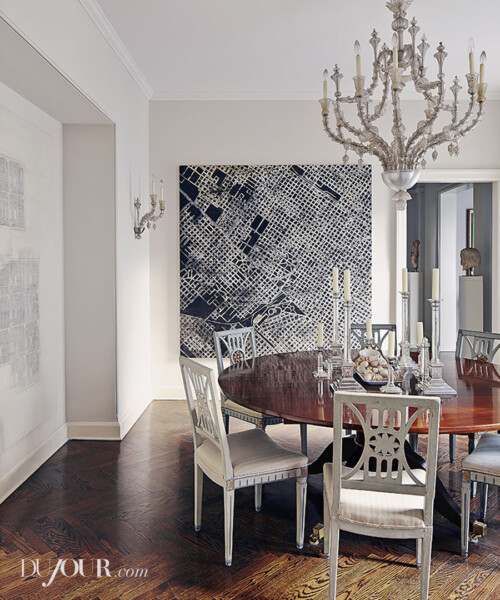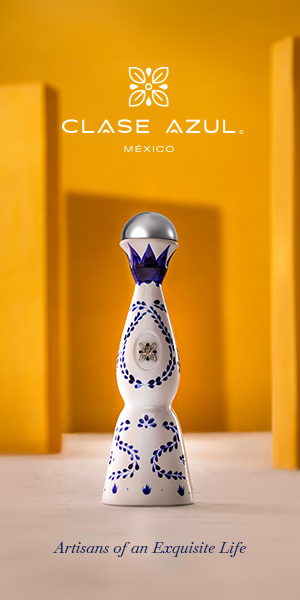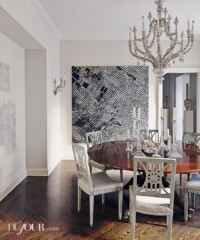Jean Arp, Cy Twombly, Sol LeWitt, Andy Warhol, Julian Schnabel and Vik Muniz. It’s an impressive array of contemporary art for a midsize museum to boast, let alone a residence. But as Angela Westwater is quick to say of her collection, “It’s not as rational in its initial conception as it might appear.” Or, as her husband, David Meitus, puts it more simply, “It’s less thought-out than you think!” Improbably enough though, neither is guilty of false modesty—there’s just a finer point to make. What brings these seemingly disparate pieces together so cohesively has everything to do with identifying what speaks to them deeply on a personal level first and figuring out why later.
When the two met in 1987, Meitus had recently moved into an award-winning glass-and-steel Chicago home; Westwater was an art dealer on the rise, with a talent roster including Bruce Nauman, Susan Rothenberg and William Wegman. “I was looking to buy, and a friend told me I absolutely had to meet Angela,” Meitus recalls. The two married in 1992 and moved into their current home, an apartment in one of Fifth Avenue’s most sought-after prewar buildings, in 1996. Westwater now co-owns (with Gian Enzo Sperone) Sperone Westwater, a soaring eight-story Norman Foster–designed gallery on the Lower East Side; Meitus owns Studium Inc., a multi-line showroom featuring furniture, flooring and mosaics.

Angela Westwater and David Meitus
With the help of designer Jed Johnson and later architect Alan Wanzenberg, the couple has created a space that’s both intimate and elegant, grand and inviting. And, more than any show her gallery might mount, it is an open-armed expression of whom and what the couple love. “You’d expect a dealer’s home to have a hierarchy of favoring her own artists over others, but there’s a democracy to how their art is hung,” says longtime friend and former Christie’s chair of postwar and contemporary art development Amy Cappellazzo. “It’s really about which artists go together, and it’s pretty damned smart the way they do it throughout so many historical periods. Angela’s artists are represented, but it doesn’t look like a showroom. It’s seamless, actually.”
Though their bedroom is devoted entirely to works by Nauman and the dining room is adorned solely with works by Guillermo Kuitca (Westwater represents both), just one wall alone in the living room displays two of Warhol’s “Reigning Queens” (Margrethe II of Denmark and Elizabeth II of England), a 1929 Francis Picabia oil painting, a pair of 1950s Jean Arp plaster figures and a terra-cotta bust of Antinous and a marble torso of Apollo from the second century a.d. “I think that there’s something about how people look at certain things, and there’s some strange thread that connects people’s aesthetic in some way,” says Meitus.

Westwater is reluctant to use the word conversation to describe the interplay of art in her home, but when she acquiesces to the characterization, she takes it a step further, explaining that placing newer pieces she acquires next to older purchases helps her understand why she likes something: “First you have a visceral, intuitive reaction when you see something. The intellectual connection doesn’t always cross your mind at first, but when you go back and research a piece, as any serious collector would do, hopefully that information helps explain why you like something, the same way placing it alongside your other pieces does, too.”
The couple staunchly refuses to let something like spatial constraints get in the way of what they want. When Meitus fell hard for an eight feet by seven feet Schnabel portrait from his “Big Girl” series, he persuaded the artist to remove an elaborate handmade frame. (“I still have the frame; I just don’t know where it is exactly.”) And when Westwater had to have Kuitca’s six feet by ten feet Corona de Espinas for the entry hall, she didn’t hesitate to have it hoisted by a crane through her living-room window some 11 stories overlooking Central Park. “We don’t tend to think of where we’ll put things first,” she says.

As for the compatibility of their styles? “Angela is more of a minimalist, and I’m more acquisitive,” Meitus offers before Westwater corrects him. “I think reductive is a better word for me. I grew up with a lot of clutter. I’m not saying that because it was bad stuff, it just was too many things for me. And I don’t think we have that here.” As Cappellazzo explains it, “There’s a kind of cleanness of thinking, which must be Angela’s good influence, and in the case of David, there’s a serious warmth and generosity to the space.”

Consistently cited for its warmth is the green velvet-walled sitting room, where Vik Muniz’s rendering in chocolate of The Reader, After Fragonard presides. “The entire apartment is beyond beautifully curated with furniture, objects and antiquities that reflect Angela’s and David’s lives, interests and taste,” says Tony Award–winning scenic designer Scott Pask. “But the study is an especially awesome enclave for a bunch of people to kick back and pile onto the deep sofa settee, cheek by jowl, for great post-dinner conversation and laughs.”
Knowing how well they’re able to mix things up aesthetically, it should come as no surprise that Westwater and Meitus’s friends speak enthusiastically about the effortless entertaining the couple has become famous for. “They’re very thoughtful about who they include. Many times they have a lot of old friends,
but there is always someone new, too,” says former White House social secretary Desirée Rogers. “If you don’t know much about art, you could be intimidated—the collection is astounding, the apartment is fabulous—but they’re so warm and personable that they let that all be the backdrop for lively discussions and debates. Every time I go there I feel like I can be exactly who I am, whether I am at a big dinner party or watching television with Angela in my pajamas.”
But perhaps it’s Calvin Klein women’s creative director Francisco Costa who says it best: “Angela and David, besides being great friends, have such incredible grace and taste and ease. Bringing intelligence and beauty together makes something captivating, and they have that quality in their home. It’s always exciting to be there.”
Click through the gallery above to see more.
MORE:
Inside Faith Kates’ Art-Filled Apartment
What’s Trending in Modern Custom Homes
Lessons from a Self-Taught Art Collector











































